
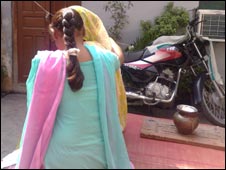 One of our goals on The Langar Hall is to raise awareness about issues affecting our community around the globe. Whether or not we identify or relate to these specific issues may not be as important as much as the acknowledgement that these issues do occur and that individuals and families and even children are affected. We hope that by raising awareness we can begin, as a community, to stand up against injustice in all its forms.
One of our goals on The Langar Hall is to raise awareness about issues affecting our community around the globe. Whether or not we identify or relate to these specific issues may not be as important as much as the acknowledgement that these issues do occur and that individuals and families and even children are affected. We hope that by raising awareness we can begin, as a community, to stand up against injustice in all its forms.
A recent article from the BBC reports that, according to campaigners in Punjab, British Asians are hiring contract killers to carry out up to 100 murders in India each year. One of the most well known cases is that of Surjit Athwal, a British Sikh woman who disappeared in Punjab in 1998. Eventually it was revealed that she had been murdered in a so-called honor killing after her in-laws discovered that she planned to divorce her husband. They had hired criminals in India to kill her. She was strangled and her body dumped in a river. Her brother, Jagdeesh Singh, now campaigns for other victims’ families.
“I think Surjit’s case exposed for the first time in this country overseas outsourced killings. How the Punjabi community, settled in Britain, send their females back to the land of origin, in the full knowledge that they can have them murdered easily, swiftly and efficiently.” [link]
So Abercrombie & Fitch is at it again or I should say has been at it for a  while-practicing bias against those who “don’t look the part” of mainstream White American society. In Tulsa, Oklahoma, a college age Muslim girl who wears a hijab is filing suit against the retail store for not hiring her because she would violate the “Look Policy”.
while-practicing bias against those who “don’t look the part” of mainstream White American society. In Tulsa, Oklahoma, a college age Muslim girl who wears a hijab is filing suit against the retail store for not hiring her because she would violate the “Look Policy”.
What is Abercrombie & Fitch’s “Look Policy”? The policy jargon aside, the bottom-line for this retail store is that hijab’s aren’t “sexy” because mainstream White America doesn’t view them that way and only sex sells.
Now of course Abercrombie & Fitch will not outright say that; though I am sure they will fight to preserve this “status quo” through legal, “objective” and “logical” means. It also seems like the very legal right that is supposed to protect religious freedom will be used to defend Abercrombie’s stance. Title VII of the Civil Rights Act of 1964 prohibits religious discrimination. The 197 amendment to Title VII defines religion to,
“… include all aspects of religious observance and practice, as well as belief, unless an employer demonstrates that he is unable to reasonably accommodate an employee’s or perspective employee’s religious observance or practice without undue hardship on the conduct of the employer’s business”.
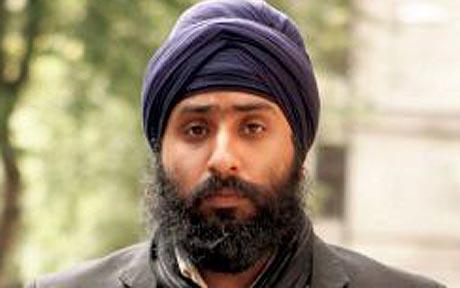 A couple of months ago the Sikh community was elated to see the Queen of England make two Sikh gentlemen her bodyguards. Thisact was seen as a huge step forward for Sikhs in the fight against discrimination for our religious articles of faith. It tremendously inspired many of us to continue the fight against Sikhs in the US Army and other places in the United States and Europe. It reflected what generations of hard Sikh work against discrimination for our religious articles of faith had done in the UK.
A couple of months ago the Sikh community was elated to see the Queen of England make two Sikh gentlemen her bodyguards. Thisact was seen as a huge step forward for Sikhs in the fight against discrimination for our religious articles of faith. It tremendously inspired many of us to continue the fight against Sikhs in the US Army and other places in the United States and Europe. It reflected what generations of hard Sikh work against discrimination for our religious articles of faith had done in the UK.
However, a recent case of a Sikh police officer in the UK feeling humiliated and offended for refusing to remove his turban as part of the Greater Manchester Police has shown us that as we take great steps forward we are still far away from taking a great leap against discrimination.
Gurmeal Singh, who is based in Wythenshawe Police station, near Manchester, said that he was coerced into walking into a petrol fire and told to wear a modified turban by colleagues. Despite telling police trainers that he had applied a flammable gel to his beard and refused to look like a character on a British comedy show, the officers told him- “this is what you signed up for”.
Singh said,
“My turban is not an article of clothing like a shirt or tie – it is part of me, a part of my religion and I feel as though my religion and I have become an issue for GMP.
“It has made me feel alienated. I was deeply offended and humiliated.”
The British Sikh Police Association are supporting Singh in his legal action. The hearing in his case continues.
 The California legislator has unanimously passed a Kirpan Education Bill (AB 504) through both houses (Assembly & Senate); it is now headed to Governor Schwarzenegger’s desk. This bill, carried by Assemblymember Warren Furutani (D-Long Beach) and other co-sponsors, will only become law if the California Governator signs off on it. AB 504 is a historic bill because it is the only piece of legislation in America that focuses on Sikhs and our kirpan. Furthermore, the bill is being pushed through the law-making process in California-a state with the oldest and largest number of Sikhs in America.
The California legislator has unanimously passed a Kirpan Education Bill (AB 504) through both houses (Assembly & Senate); it is now headed to Governor Schwarzenegger’s desk. This bill, carried by Assemblymember Warren Furutani (D-Long Beach) and other co-sponsors, will only become law if the California Governator signs off on it. AB 504 is a historic bill because it is the only piece of legislation in America that focuses on Sikhs and our kirpan. Furthermore, the bill is being pushed through the law-making process in California-a state with the oldest and largest number of Sikhs in America.
The Kirpan Education Bill (AB 504) requires that all California law enforcement officers be trained on Sikhs and our kirpan. This training would teach California law enforcement officers about Sikhs and the importance of our religiously mandated articles of faith. Sikhs wearing a kirpan are often disrespectfully approached by law enforcement officers and arrested for concealed weapons charges. Often law enforcement officers will pull Sikhs over for minor traffic violations or safety concerns and as soon as officers see the kirpan the situation is escalated into a criminal offense; although the Sikh was only practicing his/her faith. These officers are unaware that the kirpan is a religious mandated article of faith-a gift from our Guru that we wear with care, respect, and love.
Last week a Punjabi Sikh cab driver suffered a gruesome act of hate in the middle of the night in the Bay Area. He was called “Bin Laden”, a “terrorist”, and someone who had come to this country to kill Americans. His attackers where white males working professional jobs in real-estate. Not your stereotypical attackers, but committing a very typical act of hate. Although, the attackers posted bail with their money; the injured cab driver can not work to provide for his family.
We have laws to protect the attackers, but who is protecting the taxi-cab driver? How is it possible that assaulting a taxi cab driver is not a felony in every American city? Taxi cab drivers have one of the most dangerous jobs because of the environments in which they transport clients and how money for service is exchanged. They never know the character of the person they are picking up or if he/she will have enough money to pay. They function off the assumption that they won’t be attacked and their client will pay them. Otherwise, they could not make a profit in this business. They can’t let their fear overtake them.
At a recent conference, “Driving For The Future”, a taxi cab workers alliance in the Bay Area called United Taxi Cab Workers, announced that they are working towards a bill of rights. The Asian Law Caucus is working closely with this group. The bill of rights would demand, for example, that attackers suffer more severe penalties and there be a safety-net of benefits to help cab drivers who have been assaulted. In an industry employing large number of immigrant men who are not fluent in English; the need to legally protect taxi-cab drivers’ rights is very important. We need to encourage Punjabi Sikh taxi cab drivers to participate in this alliance to make sure their needs are protected.
 Often times the elderly are considered “high-cost” because they take money out of American system. They are seen as a “liability” because they withdraw medicare and social security benefits. Foriegn elders are similarly viewed as a group that “takes” through government benefits, but is not expected to serve the American system for very long.
Often times the elderly are considered “high-cost” because they take money out of American system. They are seen as a “liability” because they withdraw medicare and social security benefits. Foriegn elders are similarly viewed as a group that “takes” through government benefits, but is not expected to serve the American system for very long.
However, in a recent study at the Center for Intergenerational Learning at Temple University, scholars found that “older immigrants are not inert drains in the U.S. system but an invisible force of community contributors in the United States”.
The study found that immigrant elders contribute to community cohesion by playing leadership roles in families. Also, their sense of interconnectness, rooted in religious and cultural values, forces them to look out for the collective good. They are also a good source for motivating the younger generation to support community members.
 I’ll admit…Bollywood movies were boycotted and banned in my household as far back as I can remember, so maybe these “religious sensitivity pre-screenings” are common…but the course of events surrounding this new movie is still quite strange…even for Bollywood’s standards.
I’ll admit…Bollywood movies were boycotted and banned in my household as far back as I can remember, so maybe these “religious sensitivity pre-screenings” are common…but the course of events surrounding this new movie is still quite strange…even for Bollywood’s standards.
Last week, a new movie titled “Love Aaj Kal” was released, with Saif Ali Khan playing a Sikh as the lead male role. However, shortly before the release, the Punjab Cultural and Heritage Board objected to his portrayal of a Sikh.
Explaining their stand, Charan Singh Sapra, President of Punjabi Cultural And Heritage Board informed a tabloid, “We are objecting on the grounds that Saif is shown with a very trim beard.”
Long story short, after Khan’s formal apology and a paparazzi-filled press conference at Guru Singh Sabha Gurdwara, Dadar – 15 seconds of a questionable scene was cut from the movie and Khan declared he would not portray a Sikh “incorrectly” again in future roles. All smiles, the Punjabi Cultural And Heritage Board gave the movie “two thumbs up” and the green light to proceed.
I guess I should be happy that an organization is concerned enough about the image of Sikhs to raise such a fuss…except for the fact that we’re talking about fantasy-land. My question is…where is the organization that cares about the Sikh image in real life?
One of the three Khalsa schools in Vancouver burnt to the ground yesterday. Arson is suspected. The fire started in 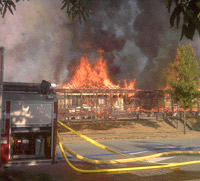 the main building and two portable classroom buildings simultaneously, and spread rapidly. The Elementary School had been broken into as well. When the school secretary called 911 to report the break-in, she saw smoke coming from one of the schools. The 911 operator told her to get out of the building and that firetrucks were on their way. [Globe and Mail]
the main building and two portable classroom buildings simultaneously, and spread rapidly. The Elementary School had been broken into as well. When the school secretary called 911 to report the break-in, she saw smoke coming from one of the schools. The 911 operator told her to get out of the building and that firetrucks were on their way. [Globe and Mail]
Firefighters brought the fire under control in 90 minutes, but of the 9 buildings that made up the Khalsa school, only one remains. They were able to save the Guru Granth Sahib Ji from the fire, making a touching scene when they carried it out to the sangat.
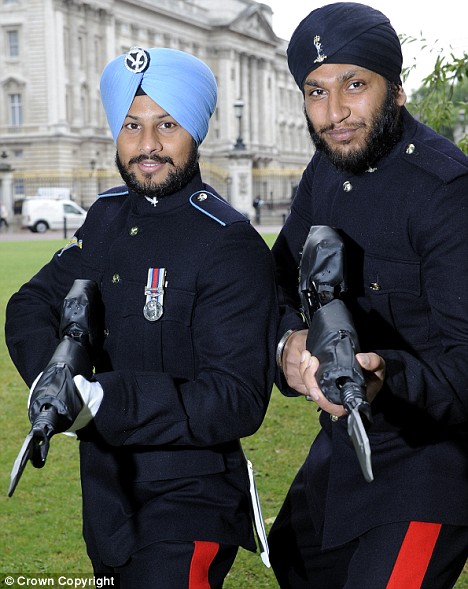 I was very impressed to see this great article (and cool pic!) in today’s Daily Mail. Along similar lines as last week’s post on the Blue Beret Kanhaiyas, it is wonderful to see Sikhs presented in this light…as confident and courageous soldiers in highly respected positions. Equally fascinating are some of the comments to the article which seem to be coming from mostly non-Sikhs, such as “Her Majesty is in safe hands with those two guarding her” and “Very smart they look too.” This is a far cry from the hate you’ll find on some of the military websites and blogs regarding the Sikh Coalition’s “Right To Serve” campaign. I hope this milestone and media attention of the Queen’s new guards will help serve as a stepping stone in this historic campaign here in the US.
I was very impressed to see this great article (and cool pic!) in today’s Daily Mail. Along similar lines as last week’s post on the Blue Beret Kanhaiyas, it is wonderful to see Sikhs presented in this light…as confident and courageous soldiers in highly respected positions. Equally fascinating are some of the comments to the article which seem to be coming from mostly non-Sikhs, such as “Her Majesty is in safe hands with those two guarding her” and “Very smart they look too.” This is a far cry from the hate you’ll find on some of the military websites and blogs regarding the Sikh Coalition’s “Right To Serve” campaign. I hope this milestone and media attention of the Queen’s new guards will help serve as a stepping stone in this historic campaign here in the US.
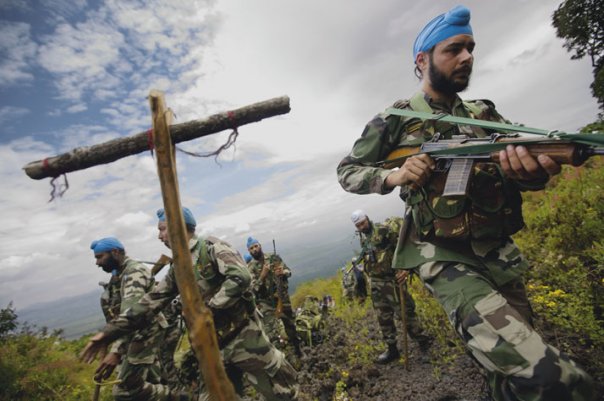
Blogged by: Amol Singh
Virunga National Park lies in Eastern Congo adjacent to Rwanda. Throughout the past fifteen years, the region has been embroiled in communal strife and has become the backdrop for some of the most wanton killings of peoples in recent history. In the battle over the area’s vast natural resources, militias, poachers, and park rangers are in a constant struggle to establish domain over the park and its enormous natural resources. The park initially became famous for its population of increasingly rare Silverback Mountain Gorillas. Although protected internationally, the gorillas (and the rangers sworn to protect them) are powerless against an illicit $30 million natural resources trade involving the pilfering of local charcoal deposits.
In a National Geographic article published last year, journalist Mark Jenkins recounts his trip inside the National Park in search of the Silverbacks. Jenkins and a team of Park Rangers were escorted by a party of Sikh UN Peacekeepers.
We hike in the next morning. Our force numbers almost 50, including 12 rangers and Muir. At its core are 18 Sikhs, all veteran fighters, commanded by Maj. Shalendra Puri. UN soldiers are typically called “blue helmets,” but in this case they are the blue turbans.
Oregon recently passed a bill to repeal its ban on religious attire in the workplace, a policy adopted 100 years ago as part of anti-Catholic backlash. However, it let stand an exception to this act — specifically, it continues to ban wearing “religious attire” in classrooms. Its decision strikes against its stated policy goal: to ameliorate religious discrimination in the workplace.
Religious affiliation is a protected class under U.S. equal protection (14th Amendment) and Civil Rights law, but it is subject to a much more lenient standard of review than other forms of discrimination (e.g., race). In 1980, the Supreme Court upheld Oregon’s workplace ban. The Legislature supports its ban by claiming that it is designed to avoid proselytization in the classroom. This is both misguided and continues to advance discrimination.
Punjab has been divided numerous times. Both during and after partition. Anita Rau Badami eloquently writes, “First it was Partition and half our land disappeared. Now our own leaders are chopping it up like a piece of meat”. The Punjabi language was one thing we hoped would cross borders despite all the “chopping”. Ultimately, it was the language of the Punjabi soul regardless of how political borders were drawn.
However, the Punjabi language is being lost. It has been granted “second language status” under the Official Language Act. Although extremely disappointing that Punjabi is given a 2nd status-one walks away thinking at least it still has some official status. However, Punjabis’ actions are speaking louder than our words when Punjabi is virtually not being taught in schools or used in official administrative work in Chandigarh. This abandonment is occurring despite the availability of financial assistance from the Central Government government to hire Punjabi language teachers. This financial assistance is supposed to cover the entire financial costs of language teachers’ appointments and salaries.
Prabhjot Singh writes for “The Tribune” that the Human Resource Development Minister Kapil Sibal (a Punjabi himself) stated:
None of the northern states other than Himachal Pradesh had applied for financial assistance for the appointment of Punjabi teachers during the past three years. Only Himachal Pradesh had obtained a grant in October 2007 for the appointment of 100 Punjabi teachers.
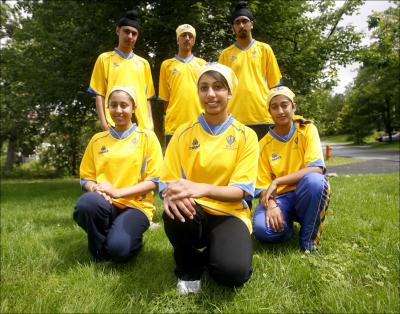
In order to provide a little bit of cheer as we head into the weekend, I thought I’d share this news bit.
A team of 32 Sikhs partnered to run across Canada, as well as fundraised $10,000, on behalf of children’s hospitals in Canada and in Africa. The runners were commemorating the 10th anniversary of a previous fundraising effort, and they hoped to expand the scope and reach of their efforts.
The runners belong to the Guru Gobind Singh Children’s Foundation, which did a fundraising run from Toronto to Ottawa 10 years ago. This year’s run is in honour of that effort, but on a much larger scale.
In addition to running legs of the race, the team had a van of supporters who provided nourishment and supplies. The runners were housed by Sikh families all across the country as they ran to Ontario, where the remainder of the relay was run by another team, in partnership.
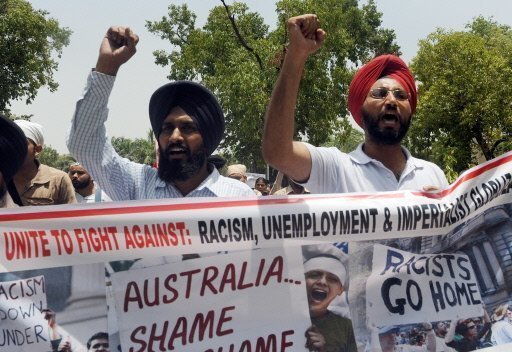 A Sikh exchange student from Punjab became the 20th victim, this year, of a hate crime in Australia. His attackers attempted to rip off his turban and forcibly cut his hair. According to the AFP, this is the latest in a wave of attacks against desis in Australia.
A Sikh exchange student from Punjab became the 20th victim, this year, of a hate crime in Australia. His attackers attempted to rip off his turban and forcibly cut his hair. According to the AFP, this is the latest in a wave of attacks against desis in Australia.
These attacks have been the subject of public protest, both among university students in Australia, and among others in India. Australia has been under pressure to address these hate crimes, and has been deploying police while claiming that these attacks are uncommon. The sheer number, however, indicate a wider tension between victims of racial hatred and violence, and their attackers. The last attack on a desi student, for example, has left the victim comatose. While the Australian government denies that these are racist attacks, the particular nature of these incidents seem to contradict this position. Does this spate of violence, then, expose the seemier underbelly of Australian race relations?
“Barter” marriages are not uncommon. My grandfather’s generation did it in Punjab because it was wise to marry two sisters to two brothers; particularly, if the family was large or wealthy. My parents’ generation did it through the “middle-person” during family negotiations in an effort to bring more relatives abroad.
What is uncommon in our generation is that “bartering” is very upfront. It is included in matrimonial ads along with height, skin complexion, and age.
Raveena Aulakh reports for the Toronto Star that some families abroad are pressured and guilted by relatives in India to figure out a way to bring their children to Canada. Siblings in Canada are accused of not wanting their nieces and nephews to have a good life. The only resort left is to run a matrimonial ad requesting a “barter” for their children or nieces/nephews in prominent Punjabi newspapers.
Aulakh writes about Jaspal Singh, a cab driver in Vancouver, who was guilted into running such an ad by his brother in India.
Finally, Singh agreed to place an ad for his own 21-year-old son and 20-year-old daughter in hopes someone, somewhere would reciprocate with Canadian matches for his niece and nephew in India.
It is not only a long shot, it is also unethical, Singh admits. He says he has told his kids he will not force them to do something they are not ready for and that weddings would take place only after they have met their prospective partners and are ready.
He has paid for the ads to run for four weeks. If things do not fall into place by then, Singh says he has no intention of following up with more ads. “How long can you do it? I will not force them to get married for the sake of it.”
Singh knows it will put a strain on his relationship with his brother, and is already dreading that conversation.
 International news outlets are a flutter with the latest: in the wake of an unseasonably hot, dry summer, the Bhakra Beas Management Board has decided to cut irrigation water to Punjab, Rajasthan, Haryana and Himachal Pradesh. The Punjab government has tried to alleviate the demand for water by curtailing its use of electricity, as well (many segments of the state run on hydroelectric power). Officials have a delayed monsoon has kept the reservoir behind the dam from being recharged. They insist the heat, and dryness, are unrelated to El Nino and a number of other weather-related phenomena.
International news outlets are a flutter with the latest: in the wake of an unseasonably hot, dry summer, the Bhakra Beas Management Board has decided to cut irrigation water to Punjab, Rajasthan, Haryana and Himachal Pradesh. The Punjab government has tried to alleviate the demand for water by curtailing its use of electricity, as well (many segments of the state run on hydroelectric power). Officials have a delayed monsoon has kept the reservoir behind the dam from being recharged. They insist the heat, and dryness, are unrelated to El Nino and a number of other weather-related phenomena.
But what if the impending drought and the water shortage are products of a more permanent weather shift? What if they are related to climate change?
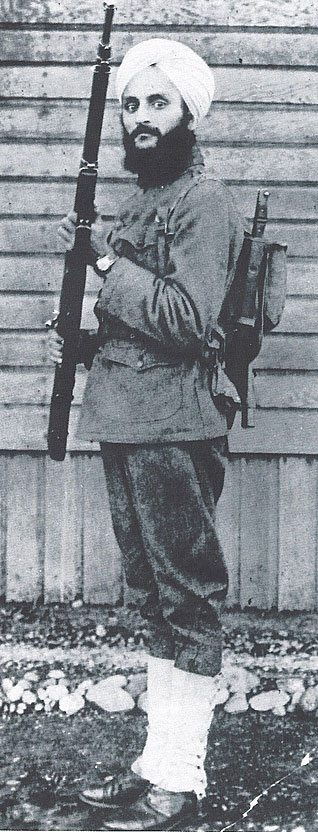 The Sikh Coalition recently announced that three Congressional representatives from New York and New Jersey wrote to Defense Secretary Robert Gates on behalf of their Sikh constituents regarding the Coalition’s “Right To Serve” campaign.
The Sikh Coalition recently announced that three Congressional representatives from New York and New Jersey wrote to Defense Secretary Robert Gates on behalf of their Sikh constituents regarding the Coalition’s “Right To Serve” campaign.
In their letters, Congresswoman Carolyn Maloney, Congressman Rodney Frelinghuysen and Congressman Joseph Crowley asked Secretary Gates to allow Sikh soldiers to serve with their articles of faith intact. The letters cited other Sikhs’ service in the US Armed Forces and in our allies’ militaries to support their argument that these men should be permitted to serve.
This an important milestone in what is likley to be a long and difficult process. In reference to this, I’d like to share a piece I wrote on sikhchic.com shortly before the launch of this campaign, titled – This We’ll Defend [The motto on the official seal of the United States Army. ]
Last fall, I went to an NFL game to watch my team face their arch rival on Sunday Night Football. As we were watching the pre-game warm-up, the gentleman next to me asked “So what do they think of football in your country?” I paused, and politely replied “Well, considering my country is America…we think pretty highly of it.” He attempted to re-phrase his question and after a few awkward exchanges, I yielded, and answered “Oh…you mean my ancestors, they are from Punjab…I’m not sure what Punjabis think of football.” We changed the topic to the upcoming game and ended our conversation.
I run in to these dialogues a lot. As I’ve gotten older, the occasional taunts and racial slurs I receive due to my articles of faith no longer faze me. I can always blame that on ignorance and lack of education. But the exchange like the one at the football game unsettles me. They are typically with people who are both educated and polite, but it is their perception that is troublesome…their presumption, that because of the way I look…I am not an American.
 Earlier this week in B.C., hundreds of Sikhs protested the arrival of Mann Singh Pehowa, a granthi accused of rape, misconduct, and blasphemy.
Earlier this week in B.C., hundreds of Sikhs protested the arrival of Mann Singh Pehowa, a granthi accused of rape, misconduct, and blasphemy.
There is, of course, an underlying issue here regarding whether or not Pehowa supports his own dera, has encouraged blasphemy, etc. There is pretty widespread criticism of him, as an individual, as well as of his behavior. I do not want to use this opportunity to get into the nitty gritty of deras and blasphemy, but rather, to focus on the issue of religion and exploitation.
Earlier in the year, Sundari discussed sexual assault in the context of a larger community-level failure to ensure gender equity. Sexual abuse is not new to faith communities, but it evokes jarring feelings of betrayal, condemnation, and deep psychological trauma, both among those who are abused and among their loved ones.
 Things are heating up as Sikh transit workers organize against the MTA’s requirement that Sikh workers wear an MTA logo on their turbans. The rationale? The MTA’s position is that this policy is necessary for customers to identify their employees. However, neither the NY City Council, nor the U.S. Department of Justice, is buying this baloney. The 27 of the City Council’s 51 members recently voted to sign onto a letter to the MTA President, opposing the policy, and the Department of Justice has revived an employment discrimination case against the MTA.
Things are heating up as Sikh transit workers organize against the MTA’s requirement that Sikh workers wear an MTA logo on their turbans. The rationale? The MTA’s position is that this policy is necessary for customers to identify their employees. However, neither the NY City Council, nor the U.S. Department of Justice, is buying this baloney. The 27 of the City Council’s 51 members recently voted to sign onto a letter to the MTA President, opposing the policy, and the Department of Justice has revived an employment discrimination case against the MTA.
There are, of course, many ways that customers can identify MTA workers, from the badges they may wear, to a uniform vest, to a standard outfit. So why attempt to brand the turban, specifically? This policy shift, along with previous failed attempts, is indicative of the MTA’s general hostility to religious inclusion and work staff diversity.
 For some Sikhs in Punjab, apparently two Harmandar Sahibs. Or at least that’s the argument between the SGPC and a group of Sikhs. The SGPC argues that a group of Sikhs are building a replica of Harmandar Sahib, and that they stridently oppose any “imitation” gurdwaras (my phrase, not theirs).
For some Sikhs in Punjab, apparently two Harmandar Sahibs. Or at least that’s the argument between the SGPC and a group of Sikhs. The SGPC argues that a group of Sikhs are building a replica of Harmandar Sahib, and that they stridently oppose any “imitation” gurdwaras (my phrase, not theirs).
The Sikhs, who are definitely building a gurdwara (but whether or not it is intended to be a replica is contested), argue that the SGPC is trying to stir up trouble and adopting wedge politics tactics to scramble for power.
At first I read this story and thought to myself, “Wow, that is wacky.” But the longer I’ve reflected on it, the more I have to ask — REALLY???
